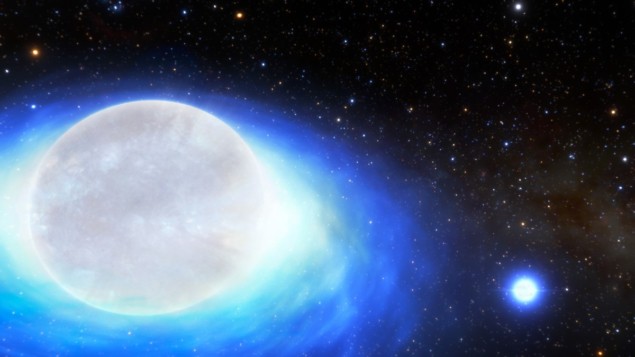
The first observation of a stellar system that is destined to explode as a kilonova has been made by astronomers in the US and New Zealand. The evolution of the rare binary star is described as a “one in 10 billion” event and could help astronomers develop a better understanding of how heavy elements are created in the universe.
A kilonova is a huge explosion caused by the merger of two neutron stars. Although kilonovas are believed to be a significant source of the universe’s heavy elements – including gold and platinum – they appear to be very rare events. Indeed, only ten kilonova progenitor systems are believed to exist amongst the 100 billion stars in the Milky Way, making this a rare and significant observation.
Designated CPD-29 2176, the system was first discovered by NASA’s Neil Gehrels Swift Observatory. Now, it has been studied in much greater detail by Noel Richardson of Arizona’s Embry-Riddle Aeronautical University and colleagues. They used data from the SMARTS telescope at the Cerro Tololo Inter-American Observatory in Chile in their study.
Gentle supernova
The team concludes that CPD-29 2176 contains two stellar objects that are in a tight orbit with each other. One object is a neutron star that was created in an ultra-stripped supernova. This is a relatively gentle stellar explosion that ejects much less material than a typical supernova. The neutron star is believed to be in a close orbit with a massive “Be” type star. Matter is being transferred from the Be star to the neutron star, which means that the Be star is in the process of becoming an ultra-stripped supernova itself.
When the Be star does explode, it will also become a neutron star. Because the explosion will be relatively mild, the binary system is expected to endure. The two tightly orbiting neutron stars will then lose orbital energy by radiating gravitational waves and eventually merge in a kilonova explosion.
Richardson explains why they became interested in CPD-29 2176. “We discovered an unusual orbit for such a binary that was oddly circular compared to other stars of this type with neutron star companions, so we began to investigate its evolution. Our team found that there had to be a rich history of binary interactions to explain the system as observed today and that it should interact again in the future.”
Tables turned
The team believes that the system had previously existed as the Be star and a larger companion star. The Be star stripped material from its companion, which then exploded in an ultra-stripped supernova to create the current neutron star. Then, the tables turned, and the neutron star began stripping the Be star, setting the Be star up for an ultra-stripped supernova.
“CPD-29 2176 is fairly close to us, only 11,400 light-years away, and reasonably bright,” Richardson explains. “This allowed us to obtain good parameters on the system and then use them to work out the evolution of such a binary. Having example systems like CPD-29 2176 allows us to piece together how to form the binary neutron stars that fuel kilonovae.”
The circular orbit of the system was key to understanding its evolution and marked CPD-29 2176 as a kilonova progenitor system. Also integral to this prediction was the fact that the Be is rotating rapidly, a relic of its time stripping mass from its companion.
Surprising circular orbit
“I was most surprised when we found the orbit was circular. We were not expecting that. Once we confirmed the orbit and our measurements, the modelling and other results were interesting,” Richardson explains.
“The [Be] star we see today needs to explode as a supernova, which will probably take a few million years,” said Richardson. “Then, in a few billion years, the two neutron stars will merge.” The long timescale associated with this process means it will be up to future astronomers to observe CPD-29 2176 going kilonova.

Spectacular collision of two neutron stars observed for first time
In the meantime, the team intends to study other binaries containing stars and neutron stars, investigating their orbital properties so they can be compared to the unusual orbits of this system. This could help identify more kilonova progenitor systems, thus potentially unlocking the secrets of these violent events.
Jillian Rastinejad is an astronomer at Northwestern University who studies kilonovae and was not involved in this study of CPD-29 2176. She is excited about the results.
“This discovery is an exciting snapshot of a previously unobserved state of these systems, lending a new eye to how they form. This leaves plenty of unknowns in how these binaries form and evolve, and how common they are in our universe.”
Richardson is the lead author of a paper published in the journal Nature that describes CPD-29 2176.



